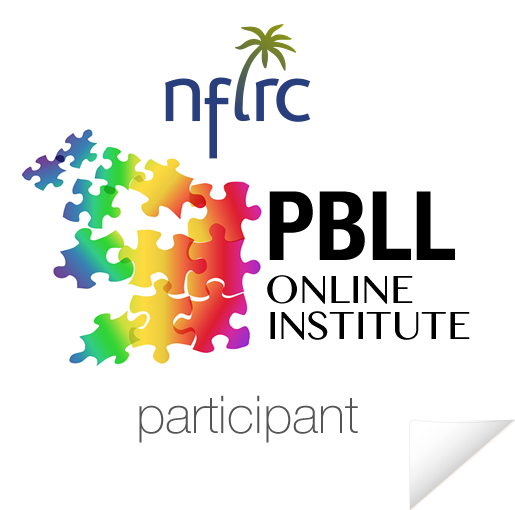Fundamentals of Project-based Language learning is an introductory online institute for world language instructors and world language curriculum and professional development specialist. Participants who complete the institute gain basic familiarity with theoretical and practical aspects of designing projects for the context of world language teaching and learning. The Online Institute progresses through five modules.
Participants who received a badge completed a Project Blueprint that specifies basic aspects of project design and interacted with colleagues in activities or discussions on this topic. Participation in the institute and completion of the Project Blueprint provide evidence that the badge recipient:
- Learned about fundamental aspects of Project-based Language Learning (PBLL) and some of the commonalities and differences between PBL and PBLL;
- Developed a world language project for a specific context and described it in a Project Blueprint document;
- Designed sample standards-based tasks that target specific areas of language learning and 21st Century Skills;
- Described an articulated sequence of project tasks and corresponding assessment;
- Participated in a collegial discussion on topics related to language learning project planning, design and implementation either by posting responses to prompts related to PBLL in the majority of the “Get Involved” sections or by soliciting and receiving feedback from colleagues on their Project Blueprint based on an adaptation of the Critical Friends Protocol.
Modules |
|
|
1 |
From PBL to PBLLLesson 1What is PBL? What are the constituent parts of a PBL unit/lesson plan? What is rigorous PBL? Lesson 2From PBL to PBLL: What do language teachers need to know about adapting PBL to the language education context? Lesson 3Developing a project idea.
|
|
2 |
Beginning Your Project PlanningLesson 4Starting with the end in mind: Defining outcomes. Addressing standards and 21st Century Skills. Lesson 5Working with Open Educational Resources (OERs). Lesson 6Infusing culture. Assessing cultural knowledge.
|
|
3 |
Language, Content & TechnologyLesson 7Using language to learn, learning to use language: Intersections with content-based instruction (CBI) and CLIL (content and language integrated instruction). Lesson 8Scaffolding for language proficiency levels. Lesson 9Scaffolding technology.
|
|
4 |
Designing Rich Learning ExperiencesLesson 10Task designs for authentic language use. Lesson 11Task designs for creativity Lesson 12Connecting learners with communities.
|
|
5 |
Designing Tasks and AssessmentLesson 13Planning interaction. Assessing interaction. Lesson 14Assessing projects. Lesson 15Finalizing your project blueprint.
|
Project Blueprint
The following are the main components of the template provided to participants to design their projects:
Project Title
Project Idea (100-200 word description)
Driving Question (50 words max!)
The Context (about 200 words)
What is your institutional context (what is your school like? what is your classroom like?)
What are the opportunities and constraints for PBLL in your context?
learners (what are your students like? what is their native language?)
What is the time frame for this project?
With regard to this project, how would you describe and assess your students’ baseline in terms of language knowledge?
Project Overview (minimum 3 rows)
Content KnowledgeStudents will learn about… |
Language KnowledgeStudents will be able to… |
Performance AssessmentStudents will do X to demonstrate they know/can do Y. |
|
Example: …past and current experiences of people in the community celebrating the Mexican Day of the Dead. |
Example: … ask questions about a past event, ask for rephrasing or repetition, ask for clarification |
Example: … write a set of interview questions on the Day of the Dead using target vocabulary and grammatical form. … conduct and record the interview with a native speaker. |
The Content
What content will students need to learn?
What open educational resources will be used in this project?
What content resources will be used (readings, media, invited speakers, etc.)
How will the project be scaffolded in terms of…?
- project process
- content
- language
- final product
What opportunities does the project create to connect with other disciplines?
The Language
What standards will this project address?
How will this project improve the learners’ interpersonal, interpretive and presentational communicative ability?
What opportunities does the project create to further develop the learners’ understanding of the culture?
What opportunities does the project create for learners to investigate, explain, and reflect on the nature of language or the concept of culture through comparisons of the target culture and their own?
What opportunities does the project create for learners to use the language beyond the classroom?
How does the project foster interaction with communities beyond the classroom?
Technology
What technologies will be used to support language learning?
What technologies will be used to support the project (e.g., communication, construction of final product, dissemination of final product)?
How will knowledge of technology be scaffolded?
Project Implementation
Preparing for the project
What task/s will be used in preparation for the project?
Launching the project
What will be the entry event?
Task sequence
Briefly describe essential signpost tasks needed for project completion
Describe at least one supporting task
Project Evaluation
What are the expected project outcomes?
How will content be assessed?
How will language be assessed?
How will 21st Century skills be assessed?
How will knowledge of the culture be assessed?
How will the final product be assessed?
Rubrics
Instructional Materials
Please include a list of handouts and worksheets. If available in text format, you may paste those materials here or provide links if they are available online.
Time for Feedback
InstructionsBefore you submit your project, we would like you to interact with your fellow participants. You can do this by either posting responses to prompts related to PBLL in the majority of the “Get Involved” sections in the Online Modules OR request feedback from at least one of your group members and make corresponding revisions. After you complete one of these, you may submit your project at http://www.nflrc.hawaii.edu/pbll-modules/. Critical Friends ProtocolPlease use this adaptation of the Critical Friends Protocol to request and give feedback.
|
Now tell us the story of your journey to create this project…Your story here |

